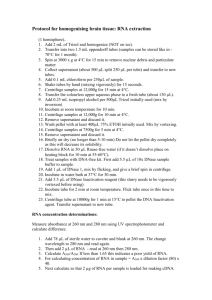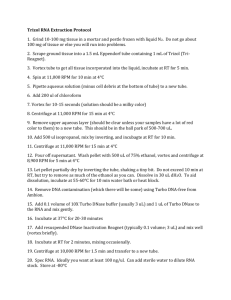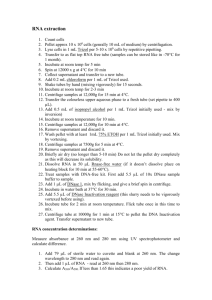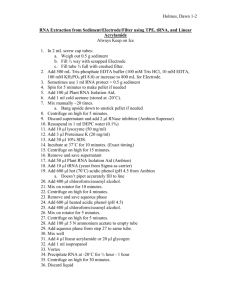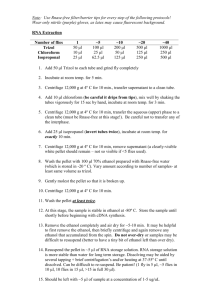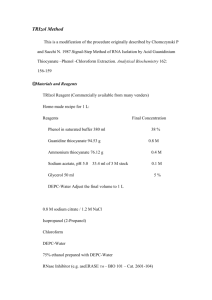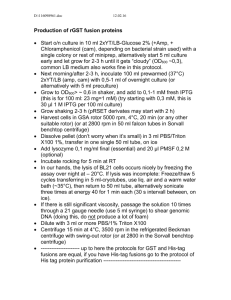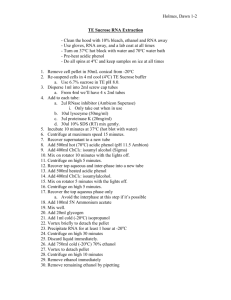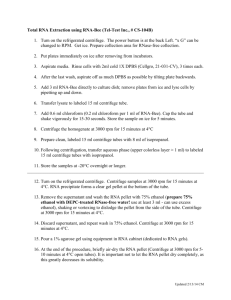Total RNA extraction
advertisement
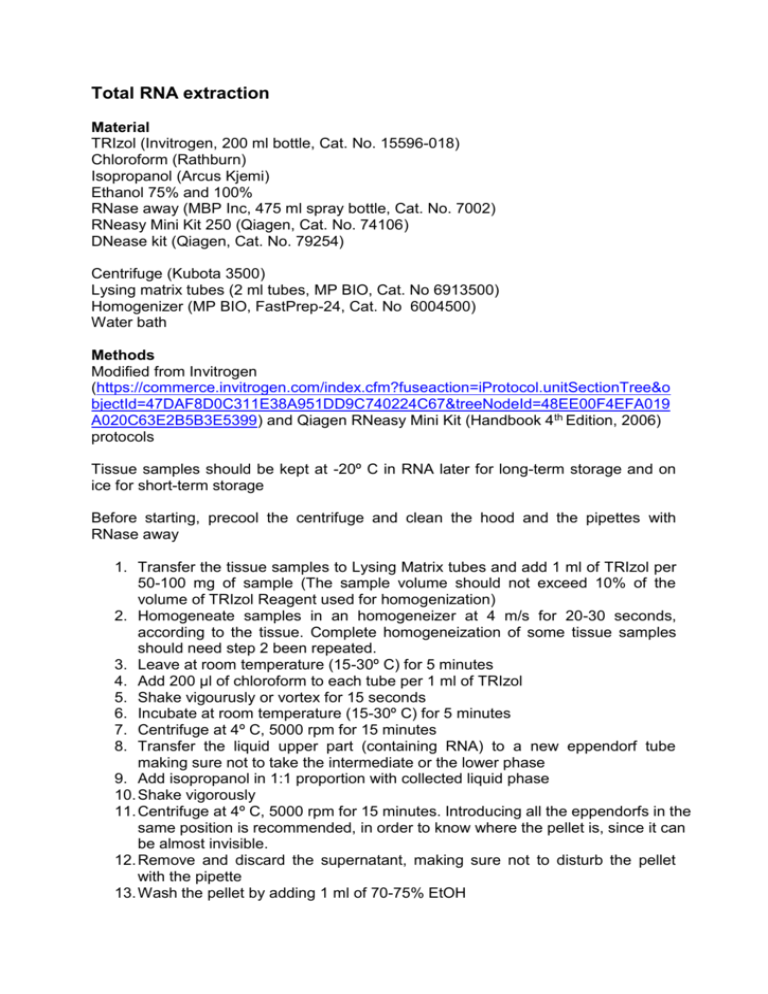
Total RNA extraction Material TRIzol (Invitrogen, 200 ml bottle, Cat. No. 15596-018) Chloroform (Rathburn) Isopropanol (Arcus Kjemi) Ethanol 75% and 100% RNase away (MBP Inc, 475 ml spray bottle, Cat. No. 7002) RNeasy Mini Kit 250 (Qiagen, Cat. No. 74106) DNease kit (Qiagen, Cat. No. 79254) Centrifuge (Kubota 3500) Lysing matrix tubes (2 ml tubes, MP BIO, Cat. No 6913500) Homogenizer (MP BIO, FastPrep-24, Cat. No 6004500) Water bath Methods Modified from Invitrogen (https://commerce.invitrogen.com/index.cfm?fuseaction=iProtocol.unitSectionTree&o bjectId=47DAF8D0C311E38A951DD9C740224C67&treeNodeId=48EE00F4EFA019 A020C63E2B5B3E5399) and Qiagen RNeasy Mini Kit (Handbook 4th Edition, 2006) protocols Tissue samples should be kept at -20º C in RNA later for long-term storage and on ice for short-term storage Before starting, precool the centrifuge and clean the hood and the pipettes with RNase away 1. Transfer the tissue samples to Lysing Matrix tubes and add 1 ml of TRIzol per 50-100 mg of sample (The sample volume should not exceed 10% of the volume of TRIzol Reagent used for homogenization) 2. Homogeneate samples in an homogeneizer at 4 m/s for 20-30 seconds, according to the tissue. Complete homogeneization of some tissue samples should need step 2 been repeated. 3. Leave at room temperature (15-30º C) for 5 minutes 4. Add 200 µl of chloroform to each tube per 1 ml of TRIzol 5. Shake vigourusly or vortex for 15 seconds 6. Incubate at room temperature (15-30º C) for 5 minutes 7. Centrifuge at 4º C, 5000 rpm for 15 minutes 8. Transfer the liquid upper part (containing RNA) to a new eppendorf tube making sure not to take the intermediate or the lower phase 9. Add isopropanol in 1:1 proportion with collected liquid phase 10. Shake vigorously 11. Centrifuge at 4º C, 5000 rpm for 15 minutes. Introducing all the eppendorfs in the same position is recommended, in order to know where the pellet is, since it can be almost invisible. 12. Remove and discard the supernatant, making sure not to disturb the pellet with the pipette 13. Wash the pellet by adding 1 ml of 70-75% EtOH 14. Vortex to resuspend the pellet and centrifuge at 4º C, 5000 rpm for 10 minutes 15. Remove the supernatant, making sure not to disturb the pellet with the pipette, and leave the pellet drying for 5-10 minutes. Make sure it is not overdried. For short-term storage of the pellet, leave the samples at – 20º C DNase digestion is necessary for qRT-PCR analysis y must be followed by RNA Clean Up 16. Add 87.5 µl RNase-free water to each tube, mix well and incubate in a water bath at 55º C for 5 minutes. Tap the tubes to help dissolve the pellet 17. Add 10 µl buffer RDD and 2.5 µl DNase I stock solution each tube (DNase solution previously prepared according to kit handbook) 18. Incubate at room temperature (20-25º C) for 10 minutes. 19. Add 350 µl of Buffer RLT and mix well 20. Add 250 µl of EtOH 100% and mix well. DO NOT CENTRIFUGE 21. Transfer the sample (700 µl) to an RNeasy Mini spin column placed in a 2 ml collection tube. 22. Centrifuge at 4º C, 10000 rpm for 1 minute 23. Discard the flow-through and reuse the collection tube 24. Add 500 µl of Buffer RPE (it is supplied as concentrate solution: remember to add ethanol in the bottle before first use, as indicated in the kit handbook) 25. Centrifuge at 4º C, 10000 rpm for 1 minute 26. Discard the flow-through and reuse the collection tube 27. Centrifuge at 4º C, 10000 rpm for 1 minute 28. Discard the flow-through and put samples on ice 29. Remove the rest of RPE Buffer eventually still present in the RNeasy spin column 30. Place the RNeasy spin column in a new 1.5 ml eppendorf tube 31. Add 40 µl of RNase-free water 32. Centrifuge at 4 C, maximum rpm for 1 minute 33. Mesaure RNA concentration by nanodrop and store at -72º C. Aliquoting the total RNA isolated is recommended. One aliquote should contain 2 µl and be used for the quality assesment of total RNA by Bioanalyzer 34. Check total RNA quality by Bioanalyzer

